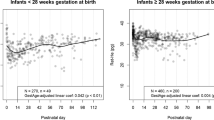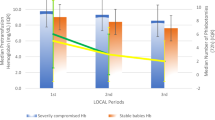Abstract
Objective:
The time between onset of fetal hypoxia and first appearance of nucleated red blood cells (NRBCs) in the blood can conceptually be divided into two periods; (1) the ‘erythropoietin (EPO) generation time’, which previous fetal studies suggest is 4 to 5 h, and (2) the ‘NRBC emergence time’. In this study, we estimated the latter as the time required for NRBC to appear in the blood after administering a dose of recombinant EPO.
Study Design:
This was a retrospective analysis of data from a multihospital healthcare system (Intermountain Healthcare). Data were included only for neonates born ⩾34 weeks gestation between the dates 1 January 2005 and 31 October 2012 and only if they received a dose of darbepoetin during their neonatal intensive care unit stay and had one or more complete blood cell counts (CBCs) obtained during the 3-day period before the dose was given and one or more CBCs in the 7-day period after the dose.
Result:
The study involved 31 neonates who received 34 doses of darbepoetin. Seven doses were 4 μg kg−1 and twenty-seven doses were 10 μg kg−1. Twenty-six CBCs were obtained during the 24-h period following the darbepoetin dose and none had NRBC identified. NRBC first appeared in the blood between 24 and 36 h after the dose. Recipients of the higher dose generally had a higher peak NRBC count but the NRBC ‘emergence time’ did not appear to depend on dose.
Conclusion:
Following fetal hypoxia, transcription and translation of the EPO gene result in an elevation in plasma EPO concentration. Previous fetal studies suggest this process requires 4 to 5 h. The present studies suggest that, following the increase in plasma EPO, NRBC emerge into the circulation in ⩾24 h. If this model serves as a reasonable estimate, it suggests that neonates with an elevated NRBC count at birth had the onset of hypoxia at least 28 to 29 h before birth.
This is a preview of subscription content, access via your institution
Access options
Subscribe to this journal
Receive 12 print issues and online access
$259.00 per year
only $21.58 per issue
Buy this article
- Purchase on Springer Link
- Instant access to full article PDF
Prices may be subject to local taxes which are calculated during checkout


Similar content being viewed by others
References
Green DW, Hendon B, Mimouni FB . Nucleated erythrocytes and intraventricular hemorrhage in preterm neonates. Pediatrics 1995; 96: 475–478.
Buonocore G, Perrone S, Gioia D, Gatti MG, Massafra C, Agosta R et al. Nucleated red blood cell count at birth as an index of perinatal brain damage. Am J Obstet Gynecol 1999; 181: 1500–1505.
Ghosh B, Mittal S, Kumar S, Dadhwal V . Prediction of perinatal asphyxia with nucleated red blood cells in cord blood of newborns. Int J Gynaecol Obstet 2003; 81: 267–271.
Perrone S, Vezzosi P, Longini M, Marzocchi B, Tanganelli D, Testa M et al. Nucleated red blood cell count in term and preterm newborns: reference values at birth. Arch Dis Child Fetal Neonatal Ed 2005; 90: F174–F175.
Ferber A, Minior VK, Bornstein E, Divon MY . Fetal "nonreassuring status" is associated with elevation of nucleated red blood cell counts and interleukin-6. Am J Obstet Gynecol 2005; 192: 1427–1429.
Phelan JP, Kirkendall C, Korst LM, Martin GI . Nucleated red blood cell and platelet counts in asphyxiated neonates sufficient to result in permanent neurologic impairment. J Matern Fetal Neonatal Med 2007; 20: 377–830.
Baschat AA, Gungor S, Kush ML, Berg C, Gembruch U, Harman CR . Nucleated red blood cell counts in the first week of life: a critical appraisal of relationships with perinatal outcome in preterm growth-restricted neonates. Am J Obstet Gynecol 2007; 197 (286): e1–e8.
Boskabadi H, Maamouri G, Sadeghian MH, Ghayour-Mobarhan M, Heidarzade M, Shakeri MT et al. Early diagnosis of perinatal asphyxia by nucleated red blood cell count: a case-control study. Arch Iran Med 2010; 13: 275–281.
Yoon D, Ponka P, Prchal JT . Hypoxia. 5. Hypoxia and hematopoiesis. Am J Physiol Cell Physiol 2011; 300: C1215–C1222.
Huang X, Pierce LJ, Chen GL, Chang KT, Spangrude GJ, Prchal JT . Erythropoietin receptor signaling regulates both erythropoiesis and megakaryopoiesis in vivo. Blood Cells Mol Dis 2010; 44: 1–6.
Yoon D, Pastore YD, Divoky V, Liu E, Mlodnicka AE, Rainey K et al. Hypoxia-inducible factor-1 deficiency results in dysregulated erythropoiesis signaling and iron homeostasis in mouse development. J Biol Chem 2006; 281: 25703–25711.
Christensen RD, Henry E, Andres RL, Bennett ST . Reference ranges for blood concentrations of nucleated red blood cells in neonates. Neonatology 2011; 99: 289–294.
Christensen RD, Baer VL, Gordon PV, Henry E, Whitaker C, Andres RL et al. Reference ranges for lymphocyte counts of neonates: associations between abnormal counts and outcomes. Pediatrics 2012; 129: e1165–e1172.
Task force on neonatal encephalopathy and cerebral palsy staff, American College of Obstetricians and Gynecologists with American Academy of Pediatrics staff. Neonatal Encephalopathy and Cerebral Palsy: Defining the Pathogenesis and Pathophysiology. The American College of Obstetricians and Gynecologists: Washington, DC, 2003.
Meadow W, Chrisanti S, Kim S, Butcher C, Ren Y, Hipps R . Does birth asphyxia “shake loose” nucleated red blood cells? Implications for theories of timing and causation in medical malpractice allegations. Pediatr Res 1996; 39: 230–230.
Rankin EB, Biju MP, Liu Q, Unger TL, Rha J, Johnson RS et al. Hypoxia-inducible factor-2 (HIF-2) regulates hepatic erythropoietin in vivo. J Clin Invest 2007; 117: 1068–1077.
Widness JA, Teramo KA, Clemons GK, Garcia JF, Cavalieri RL, Piasecki GJ et al. Temporal response of immunoreactive erythropoietin to acute hypoxemia in fetal sheep. Pediatr Res 1986; 20: 15–19.
Ebert BL, Bunn HF . Regulation of the erythropoietin gene. Blood 1999; 94: 1864–1877.
Bunn HF . New agents that stimulate erythropoiesis. Blood 2007; 109: 868–873.
Ogunshola OO, Bogdanova AY . EPO and non-hematopoietic cells: what do we know? Methods Mol Biol 2013; 982: 13–41.
Dulay AT, Buhimschi IA, Zhao G, Luo G, Abdel-Razeq S, Cackovic M et al. Nucleated red blood cells are a direct response to mediators of inflammation in newborns with early-onset neonatal sepsis. Am J Obstet Gynecol 2008; 198 (426): e1–e9.
Blackwell SC, Hallak M, Hotra JW, Refuerzo J, Hassan SS, Sokol RJ et al. Timing of fetal nucleated red blood cell count elevation in response to acute hypoxia. Biol Neonate 2004; 85: 217–220.
Warwood TL, Ohls RK, Lambert DK, Leve EA, Veng-Pedersen P, Christensen RD . Urinary excretion of darbepoetin after intravenous vs subcutaneous administration to preterm neonates. J Perinatol 2006; 26: 636–639.
Warwood TL, Ohls RK, Lambert DK, Jones C, Scoffield SH, Gupta N et al. Intravenous administration of darbepoetin to NICU patients. J Perinatol 2006; 26: 296–300.
Warwood TL, Ohls RK, Wiedmeier SE, Lambert DK, Jones C, Scoffield SH et al. Single-dose darbepoetin administration to anemic preterm neonates. J Perinatol 2005; 25: 725–730.
Vatansever U, Acunaş B, Demir M, Karasalihoglu S, Ekuklu G, Ener S et al. Nucleated red blood cell counts and erythropoietin levels in high-risk neonates. Pediatr Int 2002; 44: 590–595.
Teramo KA, Widenss JA . Increased fetal plasma and amniotic fluid erythropoietin concentrations: markers of intrauterine hypoxia. Neonatology 2009; 95: 106–116.
Moya FR, Grannum PA, Widenss JA, Clemons GK, Copel HA, Hobbins JC . Erythropoietin in human fetuses with immune hemolytic anemia and hydrops fetalis. Obstet Gynecol 1993; 82: 353–358.
Acknowledgements
We thank Josef T Prchal, MD, Departments of Internal Medicine, Genetics, and Pathology, University of Utah School of Medicine, for critically reviewing the manuscript, and Vickie L Baer, RN, Intermountain Healthcare Research, for assistance with data management.
.
Author information
Authors and Affiliations
Corresponding author
Ethics declarations
Competing interests
The authors declare no conflict of interest.
Rights and permissions
About this article
Cite this article
Christensen, R., Lambert, D. & Richards, D. Estimating the nucleated red blood cell ‘emergence time’ in neonates. J Perinatol 34, 116–119 (2014). https://doi.org/10.1038/jp.2013.113
Received:
Revised:
Accepted:
Published:
Issue Date:
DOI: https://doi.org/10.1038/jp.2013.113
Keywords
This article is cited by
-
NRBC concentrations over time in neonates with moderate to severe neonatal encephalopathy with and without sentinel events
Journal of Perinatology (2024)
-
Placental Pathology Findings in Unexplained Pregnancy Losses
Reproductive Sciences (2024)
-
Nucleated Red Blood Cell Counts Differentiate Cardiac from Respiratory Causes of Cyanosis at Birth
Pediatric Cardiology (2024)
-
Nucleated red blood cells and fetal hypoxia: a biologic marker whose ‘timing’ has come?
Journal of Perinatology (2014)



